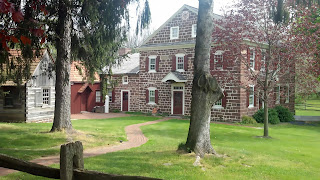Kauffman's and the Mennonites
The Middle Ages came to a close about 1550. They had been ushered in by the effects oi the Crusades which covered the time from 1100 to 1300. Contact with the East brought in new ideas resulting in a renaissance oi culture, learning. and religion. The feudal system never regained the power it lost, bleeding itself of men and wealth against the Mohammedans. The guilds gained much of the influence lost hy the barons and systematized trade and manufacture, rules and regulations. With the spread of learning, came deeper inquiry into religion bringing about bitter and intolerant controversies. Gutenberg's invention oi the press shortly before the close of the Middle Ages was a big factor in bringing the Bible to more communities and raising the fires of opposition. The numbers were many who were persecuted and martyred in the name of religion. Among these were the Mennonites. How and why the Kauffman clans became involved with the Mennonites is a mystery. But there is plenty of evidence of that involvement.
From "Martyrs' Mirror," p. 685, we learn that seven Mennonite brethren and one sister were apprehended at Antwerp early in 1569, because they lived according to the Word of God and testimony of truth. They were Jan Van Hasbrouck, Herman Zimmerman, Peter Verlonge, Gerrit Van Mandel, Jan Van Mandel. Jan Schaeffer, Jan Wiljcot, Jan Van Dornilc, Vsfilliam Van Poperingc and wife Maeykcn: Jan Kaufman and his servant Hans. They were tortured and eventually put to death, excepting one of whom died. Seven were burnt to death before Easter. The other four were burnt May 20, l659. While these martyrs were awtniting execution, their mouths were kept shut with screws to prevent them from converting others.
It is recorded that in 1654 the first settlement of Mennonites was made at Egwyl,Canton of Berne. Switzerland, consisting of forty families who had fled from persecution in Zurich. Persecution followed them. Matthias Kaufman of Kricgstettcn,Solothurn and Hellfrau in Kilchori. Goppigen, was captured Mar. 3, 1659. and imprisoned for eighteen and one half months in the jail at Berne. With him were other Mennonite teachers ond leaders. Anthony Weber of Himmelsburg; Jacob Schlabach of Obcrtlieshach: Ulrich Baumgartlner of Lnupcrwyl; Hans Zuagg of Signau; Jacob Gut (Good} of Offtringen, Hans Jacob Mumprecht of Ruegsanc: Peter Friclcr of Bigler: Benedict Baumgordner of Langnau. and Christian Christians of Langnan. They were for awhile kept at very hard work and poorly fed with heavy food, spelt, and rye to make good thc expenses they caused: besides. reproach and vituperation was heaped upon them. They were threatened life imprisonment but patiently surrendered themselves to the grace of the Lord. When it was seen they could not be dissuaded from their faith, another plan was offered: To go to the State church: or to be per- petually banished to the galleys: or to have to die by the hands of the executioner. However. none of these plans was followed. We find that on Sept. 10. 1660, they were taken, including Hans Wenger, from Berne to Brug, Holland, in a ship. They were the forerunners of the many to be banished out of Switzerland and find a welcome asylum in Holland.
Later laws were made and strictly enforced. Property was taken and held in trust until children of Mennonite parents were of age and if they were not as their parents, received their legacy. Children were taken from Mennonite parents and trained in the recognized state church {Reformed). Rewards were large: this gave an impetus to the betrayal. Imprisonment,the galleys, banishment, confiscation, and fines seemed to make more and more converts.
William Penn Steps in to help the MennonitesWilliam Penn`s familiarity with Holland and her people opened up new asylum for these Swiss refugees. The Mennonite and Quaker are very similar in belief so that learning of each other's need, Pennsylvania was the most natural center of gravity where land and freedom of conscience could be had for the taking. Penn made several trips up the Rhine Valley promoting the settlement of Pennsylvania. Rupps "30.000 Immigrants" shows how opportune·Penn's offering was considered. By 1730 the tide of immigration was large enough to make the British speaking subjects lose sleep about the "German Peril."
The Kaufmanns are plentiful in the Canton of Berne. and the various records show four distinct regions in which they are centered. One group was settled in the Alpine area about Grindelwald, lseltwalcl, and Erlenhach im Simmentol. The second group has its home in the vicinity of Thun and the neighborhood of Steffislmrg, Heimberg, and Homlberg. The third is numerous north of the city of Berne in the district of Ober Aargau at Hellsau, Herzogenbuchsee and Rutshelen and the adjacent Canton of Solothurn. A fourth spreads in the area between the Canton of Berne and France in the Jura Mountains at Rcibcn, Biel, and Epiquerez where French is spoken. It is important to note that not all Kauffman's were Mennonites. Many, if not most remained in these regions where they are today. Most Kauffman's coming to America during this period were Mennonites, many of them were related, if only distantly.
Now read "Our Kauffman's"
xi


Comments
Post a Comment